
Image: © Eva Inerki
Artwork: © The Easton Foundation/VAGA at ARS, NY and DACS, London 2022
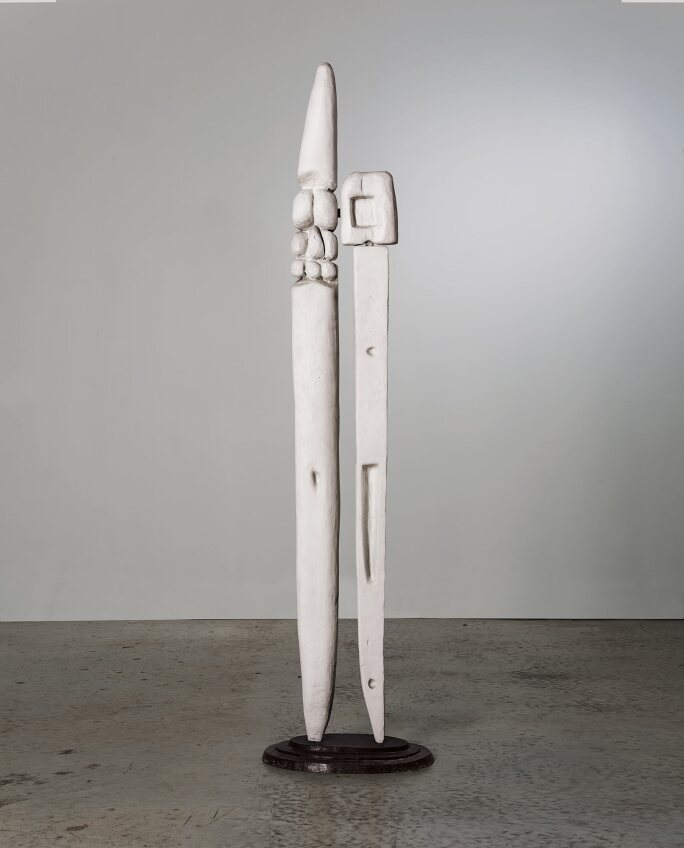
Private Collection
Artwork: © The Easton Foundation/VAGA at ARS, NY and DACS, London 2022
During the 1940s, Louise Bourgeois embarked upon her first major body of work: The Personages. Slender, upright, top-heavy and precariously balanced upon a tapering point, these solemn and spare sculptures arose from a unique set of emotional and artistic circumstances that would lay the groundwork for the next seventy years of Bourgeois’s career. The present example, entitled Listening One, is a substantial, double-totem example from this series. First hewn, chiselled, and gouged from wood in 1947, Listening One did find not expression in bronze until 1977, when the first work from a planned edition of 6 was cast and patinated with a rich dark finish. Belonging to this edition and cast in 1981, the present work counts among the first iterations (numbers 1, 2 and AP) finished with the same dark patina. Subsequent versions in the edition (numbers 3, 4, 5 and 6) emerged sequentially from the artist's studio and were painted white. Intended as a couple, Listening One is composed from two of Bourgeois’s hewn 1940s wooden edifices; one of which, titled Attentive Figures at the time, was exhibited as a single totem at Bourgeois's debut exhibition for this series at Peridot Gallery in 1949. This wooden original then appears under the same title in exhibitions from 1962 until 1970, and was finally replaced with the conclusive bronze iteration in exhibitions thereafter. Although Bourgeois intended to cast these works in bronze from the outset of their conception, as an expensive material for an artist operating under the radar of the male-dominated commercial arena, these works did not find their final iteration until the late 1970s and early 1980s. Indeed, it was only with a long-overdue recognition brought on by a reappraisal of Bourgeois’s oeuvre at this time that she was finally afforded the opportunity to fully realise this incredibly significant early body of work. Listening One is thus not only among the first of the Personages to be cast in bronze, it encapsulates the very essence of Bourgeois’s series – a body of work that today is rightfully considered a landmark of twentieth-century sculpture. Considered the highpoint of Bourgeois’s early practice, bronze and wooden iterations of these celebrated works are today housed in a litany of major museum collection worldwide, including The Museum of Modern Art, New York; Solomon R. Guggenheim Museum, New York; Whitney Museum of American Art, New York; Tate, London; and Fondation Beyeler, Basel to name only a few.
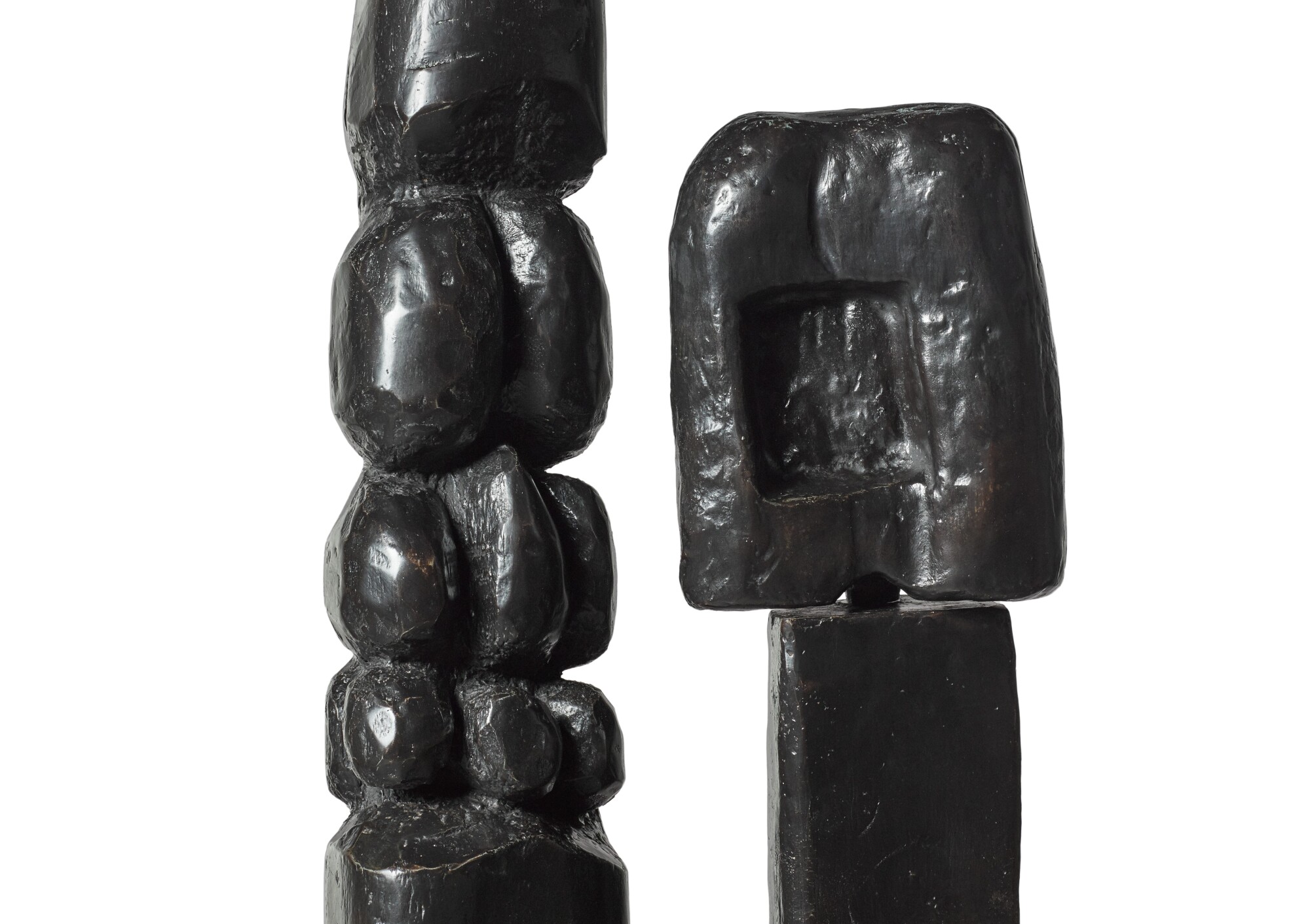
Listening One comprises two totemic forms which appear to lean in and conspire with one another. Their presence is undeniably anthropomorphic yet at the same time architectonic: what at once appear to be windows might also be bodily orifices, and what may be a roof might instead represent a head. Confusing domesticity and abstraction, architecture and corporeality, the Personage invoke a surreal encounter in real space that is irrefutably human. Though entirely abstract, the proportions and subtle poise of these forms are wonderfully authentic and undeniably social; though turning inward towards one another, their presence is comforting and contemplative.
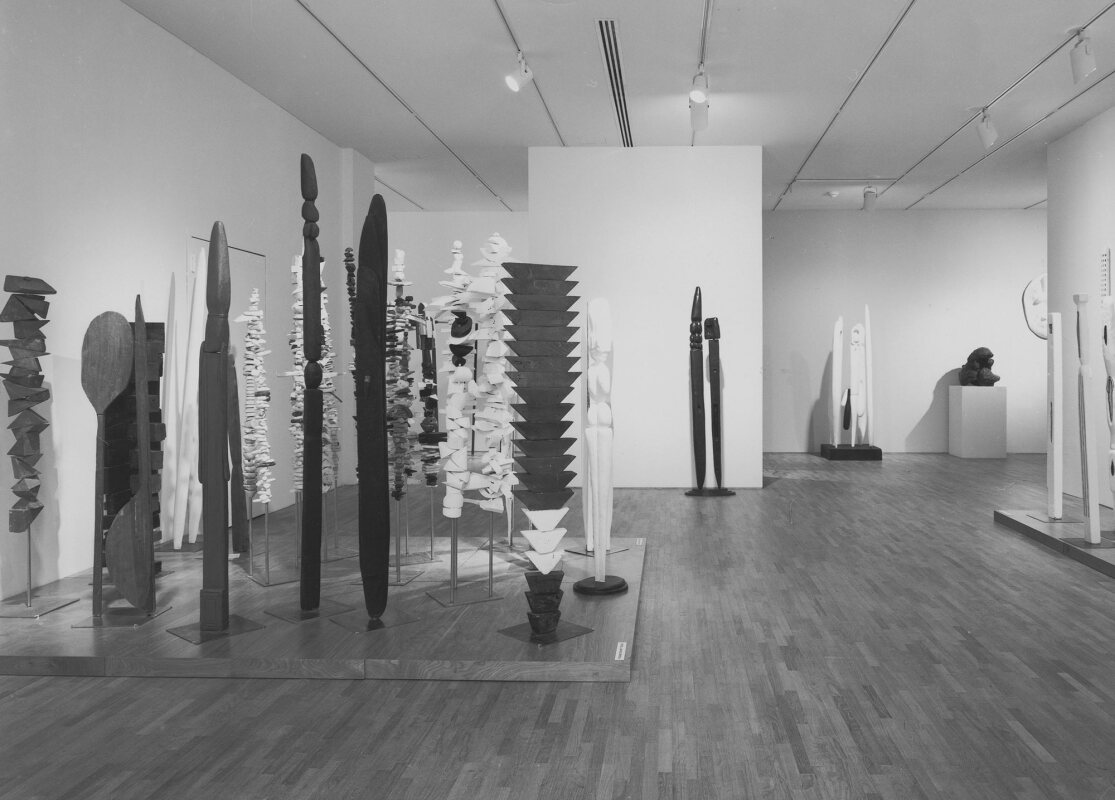
Image: © The Museum of Modern Art, New York/Scala, Florence
Artwork: © The Easton Foundation/VAGA at ARS, NY and DACS, London 2022
"The ego actively detaches itself from the lost loved one: it severs the bond… The actions of chiselling and hammering, sharpening and filing, scraping, scratching, and puncturing through which Bourgeois produced the Personages evoke this assiduous labour, recalling Freud’s description of mourning as a severing of attachment."
Positioned at the very forefront of the artistic avant-garde in New York, Bourgeois’s sculptures are inextricable from the Surrealist and Abstract Expressionist circles of which she was part; indeed, contemporary works by Max Ernst, Barnett Newman, David Smith, and Alberto Giacometti demonstrate a remarkable correlation with Bourgeois’s own sculptural innovation. As much as Bourgeois’s practice was engaged in contemporaneous aesthetic debate and cutting-edge developments, the Personages, however, were principally fuelled by an overwhelming compulsion to give physical form to very powerful and personal emotions.

Museum of Modern Art, New York
Image: © The Museum of Modern Art, New York/Scala, Florence
Artwork: © Succession Brancusi - All rights Reserved ADAGP, Paris and DACS, London 2022 Baker, Emma
In 1938 Bourgeois married the American art historian Robert Goldwater and emigrated from Paris to New York that same year. It was here, amongst the cultural and artistic elite, that she began to pursue her artistic ambitions in earnest; with the birth of her first child in 1940, the burgeoning themes of her work truly came into focus. She began producing part-figurative and part-abstract paintings that combined a response to the New York metropolis with a surrealist atmosphere of alienation and isolation. The principal motif that emerged was an amalgam of exposed corporeality and towering architecture as succinctly expressed in the series of Femme Maison paintings made between 1945 and 1947. Described by art historian and curator Robert Storr as “Bourgeois’s hopes for a geometric framework capable of containing her emotional turmoil”, these hybrid edifices encapsulate the irreconcilable differences felt by Bourgeois and, indeed, by women more generally (Robert Storr, Louise Bourgeois: Intimate Geometries, London 2016, p. 119). Although shielded within a supposed haven of domesticity, these figures are nonetheless exposed and defenceless; their protective homes, though ostensibly defensive and anonymous, are also imprisoning vehicles for compliance and conformity. Bourgeois made her art in between taking care of her children; it is of no surprise therefore that many of the very initial themes of her work touch upon ambivalent feelings towards domesticity and motherhood.
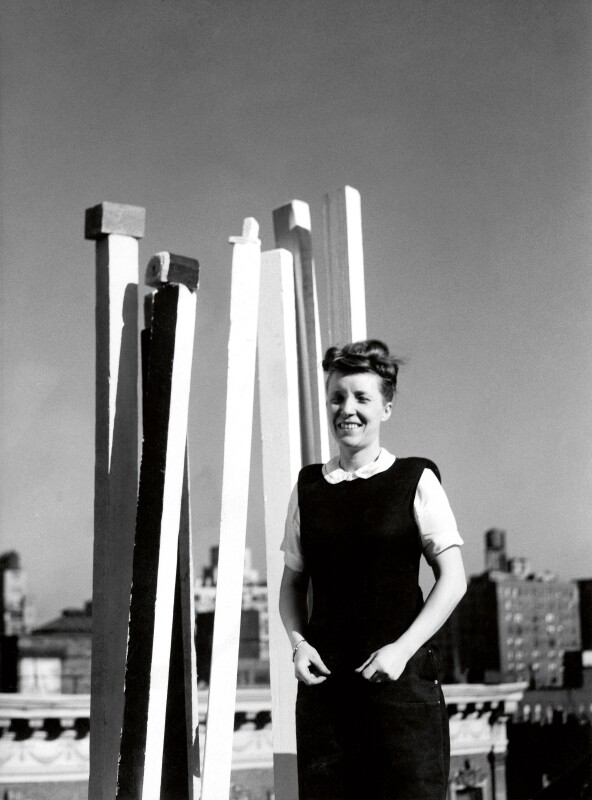
Image: © The Easton Foundation
Artwork: © The Easton Foundation / DACS, London 2022
The artist’s profound sense of homesickness during the 1940s adds a further layer of emotional complexity to these pieces; it was a very specific sense of grief, tied to a sense of loss and loneliness, that facilitated Bourgeois’s transition from painting and printmaking to working in three-dimensions. Herein, the architectonic-anthropomorphic forms of the Femme Maison paintings took on a physical dimension in 1947 with the Personages. Arising out of the artist’s desire to move beyond the confines of the two-dimensional and find an outlet for both her general restlessness (Bourgeois suffered from insomnia) and the force of her imaginative and emotional impulses, Bourgeois claimed the vacant lot on the roof of her building as a real space to think through and arrange the growing legion of monolithic figures that she began creating in wood in 1947. Using whatever materials came to hand – for example, cedar boards from water tower cladding, abandoned lumber, shop scraps and readily available balsa wood – Bourgeois cut, chiselled, and scraped these materials into slender totems of differing height and shape. While offering a response to the New York sky-line and as a corollary of the contemporary avant-garde, these pieces also served a specific psychical function. For Bourgeois, these portable and totemic forms were the human-scaled surrogates for the family members she so desperately missed. In her own words: “These pieces were presences – missed, badly missed presences… I was less interested in making sculpture at the time than in re-creating an indispensable past” (Louise Bourgeois cited in: ibid., p. 126). Principally painted white or black, and sometimes accented with shades of red and blue, the wooden Personages were figures intended to shore-up against the tides of loneliness.
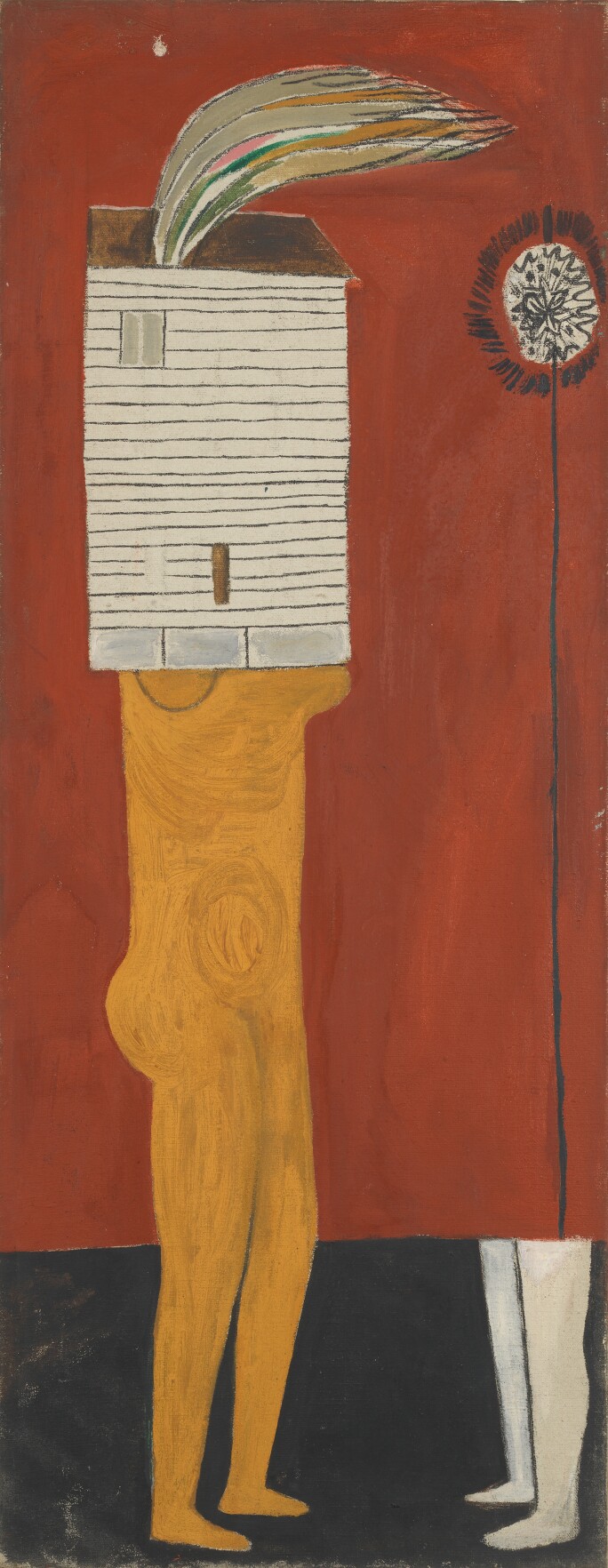
Image/Artwork: © The Easton Foundation / VAGA at ARS NY and DACS, London 2022
Having to observe the Second World War from afar, the Personages enacted a splitting of Bourgeois’s self from her absent loved ones: a process that art historian Mignon Nixon compares to the Freudian “work of mourning” (Mignon Nixon, Fantastic Reality: Louise Bourgeois and a Story of Modern Art, Cambridge, Massachusetts 2005, p. 140). Introduced in ‘Mourning and Melancholia’ (1917), Freud describes the process of mourning as one in which the grieving party overcomes their loss through a meticulous and painstaking activity of repeatedly sifting through and reliving associated memories. As observed by Nixon, “The ego actively detaches itself from the lost loved one: it severs the bond… The actions of chiselling and hammering, sharpening and filing, scraping, scratching, and puncturing through which Bourgeois produced the Personages evoke this assiduous labour, recalling Freud’s description of mourning as a severing of attachment” (Ibid.). That this process demanded concentrated and painful repetition is not only echoed in the scale of Bourgeois’s project (she created around 50 of these wooden sculptures over a period of 8 years), it is also apparent from the crowd-like groups in which they were arranged, both in Bourgeois’s home and at the first instance of their exhibition at Peridot Gallery in 1949 which included the wooden original of the present work. Indeed, Bourgeois’s psychological attachment to her familial ‘surrogates’ was such that she kept most of the carved wooden originals with her for the best part of her life; the final iteration in bronze from the 1970s onwards marked their dissemintation in the world, with the present work delivering an astounding expression from this powerful body of work.